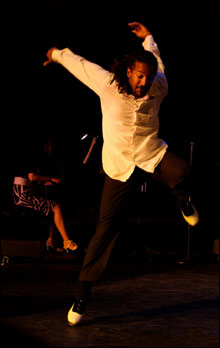
LOOSE, EVEN WILD: Aaron Tolson’s solo number incorporated slides, turns, flatfooted accents, and surprising syncopations. |
Teaching is a deep experience in tap dancing, and it's not confined to technique instruction in the studio. Teaching gets acted out in performance, as one performer lays down a line and another copies it — a friendly exchange of information that can escalate from call-and-response to virtuoso challenge. Tap dancers acknowledge their teachers; they show off their own students whenever possible. And these students, like no other practitioners of dance, understand that they're becoming part of a lineage, not just learning one more skill or having avocational fun.
This ingrained sense of history is one thing I love about tap shows. Another thing is how many different forms the act of stepping out a rhythm can generate. On the stage at the Arsenal Center's Mosesian Theater last Friday, "On Tap" showcased the faculty of the third annual Beantown Tap Fest, a week-long series of classes, jams, and showings produced by Julia Boynton. Dedicated to local jazz tap legend Pam Raff, who died last winter, the show featured New England performer-teachers, with Yoko Miwa on piano, Scott Goulding on drums, and Greg Loughman on bass. The performers included teenagers and old pros; there were show-biz routines and improvisations and Irish stepdancing and a bit of South African gumboot.
Master tapper Josh Hilberman, who MC'd the show in an orange tuxedo, demonstrated the idea of continuity with two young accomplices, Demi Remick and Joseph Sammour, in a number he called Cappella Josh. Working in the venerable a cappella tradition of singing without instrumental accompaniment, the three began with a section of unison dancing that had been rehearsed in advance. Then Hilberman started giving rhythms to the others, who improvised responses. Developing a high-stakes conversation, they wound up tapping and laughing and chasing one another through the spotlight.
Aaron Tolson and Sean Fielder showed off the performing groups they direct. Tolson, whose solo number was loose, even a bit wild, with slides, turns, flatfooted accents, and surprising syncopations, presented seven young women from his New England Tap Ensemble. Their chorus-line unison opened up to bring smaller groups of dancers into the spotlight.
Tap has developed few ways of using large groups. When the basic sound is so rich, any choreographic elaboration can be distracting. Hence, the massed ensembles and rudimentary counterpoint you see in musical shows and music video. Sean Fielder found a number of devices to give texture to the routine — and the 15 dancers — of his Boston Tap Company.
Fielder says his major objective is to show his young dancers how to find their individuality. His piece began with the dancers in fancy domino masks regimented in a marchlike conformity. The rhythms changed, and the group became a back-up chorus for a brief dramatic encounter between two girls and a lonely guy. Then the recorded music went into a jungle beat and one man showed off some locking and popping hip-hop moves against the tappers' rhythm.